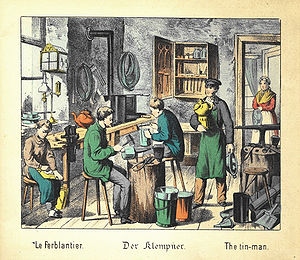And how it translated to a wide variety of trades including metal roofing and wall cladding.

Tinsmith workshop in Germany from the 1800s
Revitalizing Traditional Tinsmithing: A Legacy of Craftsmanship
For centuries, the art of tinsmithing has flourished as a venerable craft, where skilled artisans meticulously shape and mold various metals like zinc, tin, copper, and aluminum into practical and beautiful objects. Tinsmiths are known for their ability to craft an array of vessels, tanks, lamps, stoves, covers, eaves, and gutters, showcasing their expertise in metalworking.
In Hungary, the rich history of tinsmithing can be traced back to the 15th century when the craft was first established. During the 19th century, tinsmiths played a crucial role in producing an extensive range of tin pots for the peasantry. These included water immersion and wine pots, lime containers, funnels, and an assortment of household utensils such as dough strainers, graters, and watering cans. As the 20th century dawned, tinsmiths expanded their repertoire to cater to the needs of the wealthier urban population. They skillfully crafted essential equipment for bathrooms, including bathtubs, rinsing chairs, and water heaters.
Unfortunately, the advent of factory-made products in the latter half of the 20th century led to a significant decline in traditional tinsmithing. Today, only the building tinsmithing profession has managed to endure, preserving the craft and its heritage.
The role of a tinsmith in contemporary times primarily revolves around developing and manufacturing tinsmith facilities that ensure the watertightness of roofs and building components. From cornices and eaves to window sills, chimney edges, gutters, and roof gutters, tinsmiths play a vital role in maintaining the integrity of structures. They also lend their expertise to creating decorative elements like confluences and weather vanes, which are meticulously installed on-site, enhancing the aesthetics of buildings.
In specialized departments focusing on pottery, lamp-making, and stove-making, tinsmith masters meticulously work on individual orders, showcasing their craftsmanship and attention to detail.
Rooted in the traditions of blacksmithing and locksmithing, tinsmithing techniques and tools have evolved over time, incorporating the use of tinplate materials. Many tools used by tinsmiths have been inherited from these trades, while their working methods also draw inspiration from goldsmithing and coppersmithing.
Tinsmiths employ a diverse range of tools, including various types of hammers with over 30 distinct profiles, wooden hammers, sheet metal shears, capital shears, pliers, vices, anvils (both capital and hand-held), crimping irons, drilling and bending machines, punches, chisels, markers, soldering accessories, and more. These tools enable tinsmiths to shape, form, and manipulate metal sheets with precision and artistry.
Traditionally, tinsmiths worked with black tin (iron plate) and white tin (tinned iron plate). The process began with the careful hammering of the material’s surface to achieve a smoother finish. Then, a plate was meticulously cut out from the flattened material. In modern times, templates or sample plates often guide the drawing process, ensuring accuracy and consistency. Using shaped anvils, profile irons, and hammers, tinsmiths bend and extend the plate to achieve the desired shape. Techniques such as bending, expanding, embossing, straightening, crimping, and riveting and/or soldering are skillfully employed to transform metal sheets into a variety of objects.
While rivets were traditionally used for joining sheets together, providing a temporary but not completely watertight seal, soldering techniques using solder tin, soldering grease (for surface preparation), soldering irons, and portable small hobs have gained popularity. By carefully heating the copper tip of the soldering iron to a temperature of 250-350°C (482-662°F), tinsmiths melt the tin at the soldering site, spreading it onto the plate parts. Once cooled, the soldered surfaces securely fix the metal sheets, allowing for the joining of finished machined plate surfaces or parts without significant deformation.
When constructing a plate stove, tinsmiths begin by creating the appropriate iron frame, to which cut plates are riveted and fastened. The interior of the stove is then carefully scraped or coated with clay to ensure proper sealing. The final plate is installed to close the space, and legs obtained from the foundry are attached to complete the product, resulting in a functional and aesthetically pleasing stove.
The legacy of “water tinsmithing” found new life in the plumbing profession, and with the rise of motor vehicles, tinsmiths began exploring the realm of sheet metal cladding, giving birth to a new profession: the car bodybuilder.
We are proud to continue the centuries-old lineage of craftsmen who have honed their skills and expertise in various fields of tinsmithing. Our specific training and background enable us to deliver exceptional and hassle-free outcomes for your building projects. Whether you require a metal roof or wall, we are confident in our ability to address every issue and provide unparalleled solutions.
Experience firsthand how our mastery of the tinsmithing craft can elevate your projects to new heights, preserving the legacy of tradition while embracing modern techniques and innovation.
